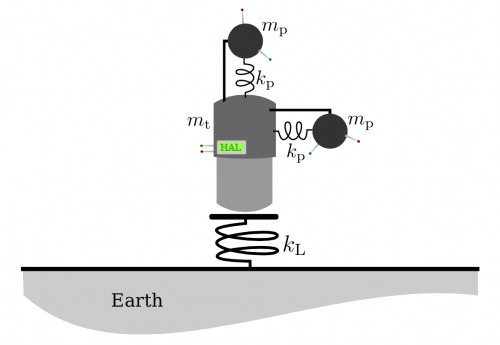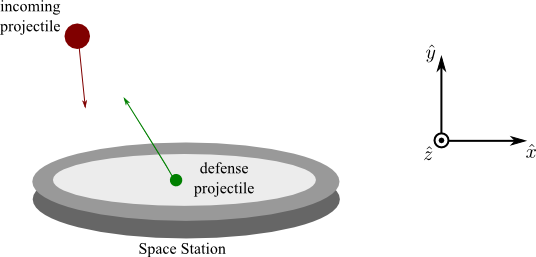This is an old revision of the document!
Project 9A: Launching Communications Probe
You and your team are engineers that have been contracted by Elliot Carver of the Carver Media Group Network (CMGN) to plan the launch of their new “communications” satellite. The satellite is meant to perform a geosynchronous pole-to-pole orbit.
The satellite consists of a transmitter of mass ($m_t$ = 4500kg) connected to two perpendicularly directed ejectable spring-loaded probes (each having mass $m_p$ = 400kg). Each probe is connected to a single, very stiff spring ($k_p$ = $5.3\times10^9$ N/m). The probes can be ejected by remote control from the CMGN headquarters in Freer, Texas; springs can be compressed as needed. A mockup from CMGN's lead designer, Wai Lin, appears below.
CMGN is going green with their satellite launches. Their new design uses no fossil fuels. The satellite itself is launched from CMGN's launch facility in the South Pole with yet another spring system, oriented vertically with respect to the flat launching platform. This very stiff spring ($k_L$ = $8.3\times10^8$ N/m) can be compressed as needed.
The satellite contains a gyroscope that self-orients the satellite with respect to the gravitational force due to the Earth, such that the satellite remains in its original orientation throughout the entirety of its trip.
Carver needs you to plan the launch and any subsequent course corrections needed to get the satellite into a geosynchronous pole-to-pole orbit.
Project 9B: Bob and Blobs
You live on the planet Bob. Bob (Bob has a radius of 8432 Km and a mass of 6.822 × 10^26 kg). The industrial revolution on Bob has transpired differently than on Earth due to mainly the ability to construct springs of extremely large spring constants. The space program of the planet Bob is reliant on springs to send objects into orbit and for propulsion. However, the scientific community has recently moved to experiment with new forms of energy such as nuclear power. One of these experiments has been the sending of a nuclear-powered satellite (mass of 6900 kg) into orbit around Bob at a distance of 22,600 Km. However, issues have arisen with the coolant system of the satellite and it is in danger of exploding and releasing harmful radiation into the upper atmosphere of Bob. You must set the satellite on a path outside of the gravitational pull of Bob in order to save the day. To do so, you have the ability to fire large blobs of a putty-like substance from the surface of Bob. The biggest blob you have access to is of mass 5000kg. What spring constant do you need to fire a blob to hit the satellite and send beyond the gravitational pull of Bob.
Project 9C: Space Force Defense
The newly established and totally needed “space force” is in a precarious situation. Their newly established space station is under threat of an asteroid hitting it. A renowned scientist, David Lightman, approaches you to solve the problem and tells you that there is a defunct Earth defense floating space station that is very far from Earth which can be hacked into. You have been tasked with operating this projectile defense system (PDS for short). PDS has the ability to launch defense projectiles from the space station headquarters (positioned at the center of the space station) to divert incoming attack projectiles (asteroids heading for the space station). Before the first firing of a projectile from the defense system, Dr. Lightman would like to see a simulation showing how the incoming attack projectile's motion can be changed by the defense projectile to be sure that you can be trusted with the PDS.
- The mass of a defense projectile is about $20\,{\rm kg}$, made out of sticky Space Clay™.
- The average mass of an attack projectile is about $5$ times that of a defense projectile, usually made of a solid metallic material.
Complete the code below to simulate before and after an interception (collision) for a worst case scenario: an attack projectile being launched directly towards headquarters at its largest ever recorded velocity $\langle 225,-400,0 \rangle\,{\rm m/s}$ from its closest ever recorded position $\langle -500,900,0 \rangle\,{\rm m}$. For this worst case scenario defense to be successful, you must push the incoming attack projectile back along its incoming path so that its velocity is $\langle -450,800,0 \rangle\,{\rm m/s}$. Your code should be general enough to handle other attack and defense projectile initial conditions.
Furthermore, the Department of Projectile Energy (DoPE) would like a report on the loss of kinetic energy during the collision as it interested in further harnessing the power of the PDS once this asteroids problem is over. Develop a graph to help answer how much energy is lost.
https://www.glowscript.org/#/user/paul.w.irving/folder/Public/program/SpaceStationCollision
Project 9: Launching Communications Probe
You and your team are engineers that have been contracted by Elliot Carver of the Carver Media Group Network (CMGN) to plan the launch of their new “communications” satellite. The satellite is meant to perform a geosynchronous pole-to-pole orbit.
The satellite consists of a transmitter of mass ($m_t$ = 4500kg) connected to two perpendicularly directed ejectable spring-loaded probes (each having mass $m_p$ = 400kg). Each probe is connected to a single, very stiff spring ($k_p$ = $5.3\times10^9$ N/m). The probes can be ejected by remote control from the CMGN headquarters in Freer, Texas; springs can be compressed as needed. A mockup from CMGN's lead designer, Wai Lin, appears below.
CMGN is going green with their satellite launches. Their new design uses no fossil fuels. The satellite itself is launched from CMGN's launch facility in the South Pole with yet another spring system, oriented vertically with respect to the flat launching platform. This very stiff spring ($k_L$ = $8.3\times10^8$ N/m) can be compressed as needed.
The satellite contains a gyroscope that self-orients the satellite with respect to the gravitational force due to the Earth, such that the satellite remains in its original orientation throughout the entirety of its trip.
Carver needs you to plan the launch and any subsequent course corrections needed to get the satellite into a geosynchronous pole-to-pole orbit.

